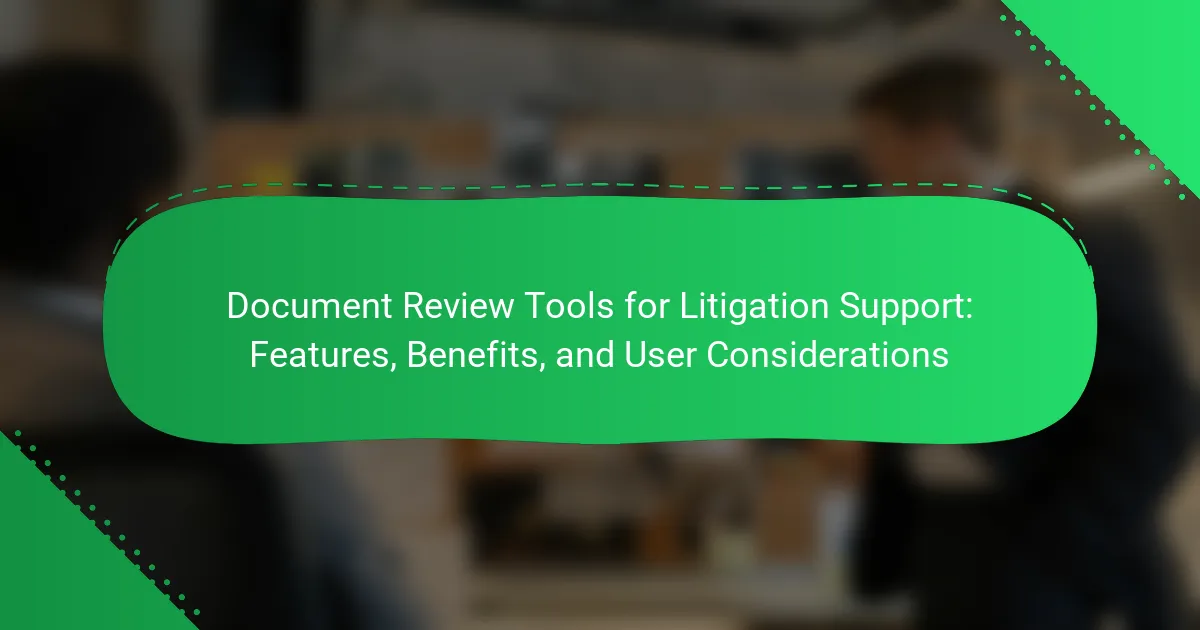Document review tools for litigation support are specialized software applications that aid legal professionals in managing and analyzing documents during legal proceedings. These tools streamline the organization of extensive document collections, enabling users to efficiently identify pertinent information through features like keyword searching, tagging, and document comparison. By enhancing both efficiency and accuracy in the review process, these applications are increasingly adopted, with 70% of law firms reported to use them for improving workflows and reducing costs. This article examines the essential features, benefits, and user considerations associated with document review tools, providing a comprehensive overview for legal professionals seeking to optimize their document management strategies.

What are Document Review Tools for Litigation Support?
Document review tools for litigation support are software applications designed to assist legal professionals in managing and analyzing documents during legal proceedings. These tools facilitate the organization of large volumes of documents, making it easier to identify relevant information. They often include features such as keyword searching, tagging, and document comparison. Document review tools enhance efficiency and accuracy in the review process. According to a report by the International Legal Technology Association, 70% of law firms utilize document review software to streamline their workflows and reduce costs.
How do Document Review Tools assist in the litigation process?
Document Review Tools assist in the litigation process by streamlining the analysis of large volumes of documents. They enable legal teams to efficiently organize, search, and review case-related documents. These tools often use advanced algorithms for data extraction and categorization. They enhance collaboration among team members by providing a centralized platform for document management. Document Review Tools also improve accuracy by minimizing human error during the review process. Furthermore, they often include features for tracking changes and maintaining version control. According to a study by the International Legal Technology Association, these tools can reduce document review time by up to 50%. This efficiency ultimately leads to cost savings for law firms and clients.
What are the key functionalities of Document Review Tools?
Document review tools primarily facilitate the efficient analysis of legal documents. They allow users to categorize, annotate, and search documents quickly. These tools often include features for keyword searching and filtering to find relevant information. They support collaborative review by enabling multiple users to access and comment on documents simultaneously. Many document review tools also provide version control to track changes and maintain document integrity. Additionally, they often integrate with case management systems for streamlined workflows. Analytics features can help identify trends and insights from the reviewed documents. These functionalities enhance the overall efficiency and accuracy of the document review process in litigation support.
What types of documents can be reviewed using these tools?
Document review tools can be used to review various types of documents relevant to litigation. These include legal briefs, contracts, and discovery documents. Additionally, they can handle emails, text messages, and other electronic communications. Document review tools also support the analysis of invoices and financial records. They facilitate the review of reports and witness statements as well. These tools are designed to streamline the process of organizing and analyzing large volumes of documents. Their capabilities ensure that all pertinent information is accessible for legal proceedings.
What are the primary benefits of using Document Review Tools?
Document review tools enhance efficiency and accuracy in legal document analysis. They streamline the review process by automating repetitive tasks. These tools often include advanced search capabilities, allowing users to find relevant information quickly. They also facilitate collaboration among team members through shared access to documents. Document review tools can improve compliance by ensuring that all necessary information is considered. Additionally, they help in reducing human error by providing consistent results. Many tools offer analytics features to track progress and identify bottlenecks. Overall, the use of document review tools can lead to significant time and cost savings in litigation support.
How do these tools enhance efficiency in document management?
Document review tools enhance efficiency in document management by automating the organization and retrieval of files. They streamline workflows through features like keyword search and tagging. This reduces the time needed to locate specific documents. Additionally, these tools often include collaboration features, allowing multiple users to work simultaneously. This capability minimizes delays caused by back-and-forth communication. Furthermore, analytics features can provide insights into document usage and trends. According to a study by the American Bar Association, firms using document management tools reported a 30% increase in productivity. Overall, these tools significantly improve the speed and accuracy of document management processes.
What cost savings can be achieved through the use of Document Review Tools?
Document Review Tools can achieve significant cost savings in litigation processes. These tools reduce manual labor by automating document analysis and review. Automation leads to faster processing times, which decreases billable hours for legal teams. Studies show that firms using these tools can cut review costs by up to 30%. They also minimize errors, reducing the risk of costly mistakes in legal proceedings. Additionally, centralized document management lowers storage and retrieval costs. Overall, Document Review Tools enhance efficiency and drive down expenses in legal workflows.
What features should be considered when selecting Document Review Tools?
When selecting Document Review Tools, consider features such as user interface, collaboration capabilities, and data security. A user-friendly interface enhances efficiency during the review process. Collaboration features allow multiple users to work simultaneously, improving teamwork. Data security is crucial to protect sensitive information during litigation. Other important features include advanced search functions, document tagging, and integration with other legal software. Advanced search capabilities enable quick retrieval of relevant documents. Document tagging aids in organizing files for easier access. Integration with existing systems streamlines workflows and reduces redundancy. These features collectively enhance the effectiveness of document review in litigation support.
How important is user interface design in Document Review Tools?
User interface design is crucial in Document Review Tools. A well-designed interface enhances user experience and efficiency. It allows users to navigate documents easily and locate information quickly. Poor interface design can lead to frustration and decreased productivity. Research indicates that user-friendly designs improve task completion rates by up to 30%. Effective user interface design also reduces training time for new users. This is essential in high-stakes environments like litigation support. Therefore, investing in quality user interface design is vital for maximizing the effectiveness of Document Review Tools.
What security features are essential for Document Review Tools?
Essential security features for Document Review Tools include data encryption, user authentication, and access controls. Data encryption protects sensitive information from unauthorized access during storage and transmission. User authentication ensures that only authorized personnel can access the tool, preventing breaches. Access controls limit user permissions based on roles, further securing sensitive documents. Additionally, audit trails track user activity, providing accountability and transparency. Regular security updates and compliance with industry standards, such as GDPR, enhance overall security. These features collectively safeguard confidential information and maintain the integrity of the document review process.
What user considerations should be taken into account?
User considerations for document review tools in litigation support include usability, integration, security, and scalability. Usability ensures that users can navigate the tool efficiently. A user-friendly interface reduces training time and increases productivity. Integration with existing systems is crucial for seamless workflow. Security features protect sensitive information, which is vital in legal contexts. Scalability allows the tool to accommodate varying case sizes and user numbers. Additionally, support and training resources should be readily available to assist users. These considerations enhance overall effectiveness and user satisfaction in litigation support scenarios.
How does user training impact the effectiveness of Document Review Tools?
User training significantly enhances the effectiveness of Document Review Tools. Trained users are more adept at utilizing the features of these tools. This proficiency leads to quicker and more accurate document reviews. Studies indicate that effective training can reduce review time by up to 30%. Additionally, trained users are better at identifying relevant documents. This results in improved case outcomes due to more comprehensive evidence analysis. Overall, user training directly correlates with the efficiency and accuracy of document review processes.
What are common challenges users face with Document Review Tools?
Users face several common challenges with Document Review Tools. One major issue is the steep learning curve associated with complex interfaces. Many users struggle to navigate features effectively, leading to inefficiencies. Another challenge is the inconsistency in document formatting. This can hinder the review process and cause errors. Users also report difficulties in collaboration among team members. Real-time editing and communication features are often lacking or underperforming. Additionally, performance issues such as slow loading times can disrupt workflows. Lastly, users frequently encounter problems with data security and compliance. Ensuring sensitive information remains protected is a top concern. These challenges highlight the need for user-friendly and secure Document Review Tools.
How do Document Review Tools integrate with other litigation software?
Document review tools integrate with other litigation software through APIs and data exchange protocols. These integrations allow seamless transfer of documents and metadata between systems. For example, many document review tools can connect with case management software. This connection enables users to access case files directly within the review platform. Additionally, integration with e-discovery tools enhances the document analysis process. Users can import data sets for review without manual entry. Many tools also support exporting reviewed documents to trial presentation software. This streamlines the preparation for court presentations. Overall, integration improves workflow efficiency and data management in litigation processes.
What are the benefits of integration with case management systems?
Integration with case management systems enhances efficiency and organization in legal practices. It streamlines the workflow by centralizing case information. This reduces the risk of data loss and improves access to critical documents. Integration also facilitates real-time updates, ensuring all team members are informed. It can automate repetitive tasks, saving time and reducing human error. Moreover, it enhances collaboration among team members by providing a unified platform. According to a study by the American Bar Association, firms that utilize integrated systems report higher productivity levels.
How can Document Review Tools work alongside eDiscovery platforms?
Document review tools can enhance the functionality of eDiscovery platforms by streamlining the review process. These tools facilitate the organization and analysis of large volumes of documents. They allow legal teams to tag, annotate, and categorize documents effectively. This integration speeds up the identification of relevant information. Document review tools can also provide advanced search capabilities, improving accuracy in finding pertinent data. Additionally, they often include collaboration features, enabling team members to work together seamlessly. The combination of these tools with eDiscovery platforms ensures a more efficient workflow. This synergy ultimately leads to reduced time and costs associated with litigation support.
What best practices should users follow when utilizing Document Review Tools?
Users should follow several best practices when utilizing Document Review Tools. First, they should ensure proper training on the tool’s features. Familiarity with functionalities enhances efficiency. Users must organize documents systematically within the tool. This organization aids in quick access and review. Implementing consistent labeling and tagging is crucial. It helps in categorizing documents for easier retrieval.
Regularly updating the review tool is necessary. Updates often include security patches and new features. Users should maintain clear communication with team members. This collaboration fosters better understanding and workflow. Additionally, users should back up important data frequently. This backup protects against data loss.
Lastly, users should review feedback on the tool’s performance. Analyzing feedback helps in identifying areas for improvement. Following these practices increases the effectiveness of Document Review Tools in litigation support.
Document Review Tools are specialized software applications that assist legal professionals in managing and analyzing documents during litigation. This article covers their key functionalities, including efficient document organization, advanced search capabilities, and collaboration features that enhance the review process. It highlights the benefits of using these tools, such as increased efficiency, reduced costs, and improved accuracy, while also addressing user considerations like interface design, security features, and training needs. Additionally, the article explores the integration of Document Review Tools with other litigation software and best practices for maximizing their effectiveness in legal workflows.



